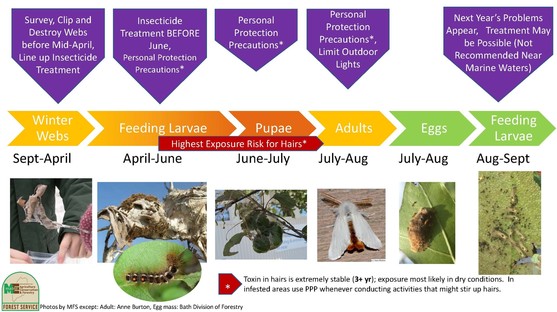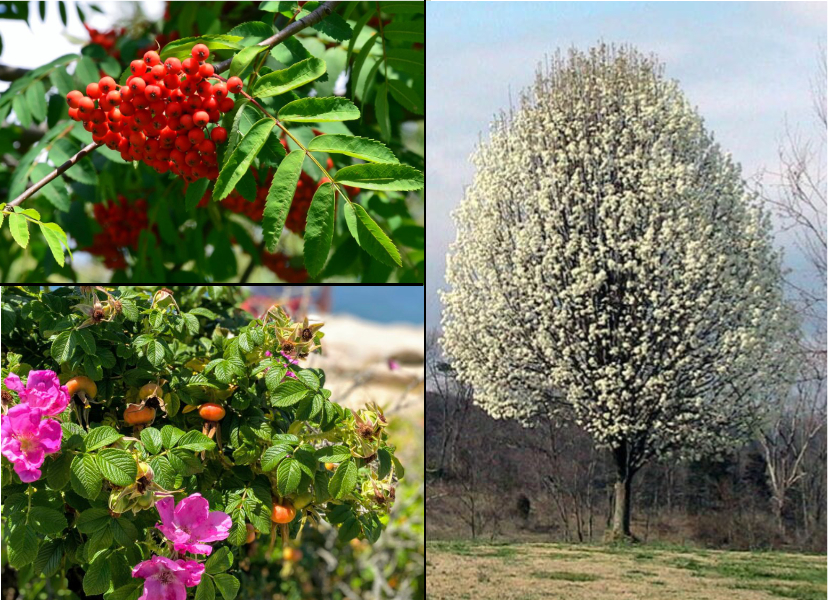MELeaf: A Newsletter from the Horticulture Program, June 9, 2022
In this issue:
The February 2022 MELeaf an article on how plant sellers can manage browntail moth throughout the year. Now that browntail moth caterpillars are busy munching through the trees and shedding itchy hairs everywhere we wanted to revisit some of the advice that can be put into action now. Follow these steps to reduce the potential that browntail moth caterpillars and pupa will move onto the plants you offer for sale.
-
Train: Train staff to recognize all life stages of browntail moth and how to protect themselves from itchy caterpillar hairs.
-
Plant Placement: Avoid placing plants offered for sale under or near heavily infested trees and shrubs.
-
Inspection: Inspect plants daily and remove any caterpillars and pupa. Avoid contact with hairs by wearing gloves, long sleeves, long pants and washing after exposure. Re-inspect plants at the point of sale and remove any browntail moth life stages present. Wandering caterpillars on buildings, the ground or other hard surfaces can be washed off with a hose and vacuumed up using a wet/dry vac with HEPA filter and filled with a few inches of soapy water.
-
Treatment: Plants offered for sale can be treated with a registered insecticide labeled for use on nursery plants. Follow pesticide label directions and continue to treat plants as long as caterpillars are present. Please note, this differs from the timing for insecticide treatment of landscape trees and shrubs.
-
Educate: Educate customers on how to recognize browntail moth, how they can reduce exposure to toxic hairs and where to find reliable, accurate management information. The caterpillar treatment window for this year is now past. Insecticide treatment of landscape plants should occur before mid-May to reduce the impact on trees and shrubs and minimize exposure to toxic hairs.
Businesses that want to look ahead to the steps they can take during the adult flight season in July and August should check out the July 2021 issue of the MELeaf, it has a good list of summertime browntail moth management strategies for plant sellers.
 Browntail moth life stages
The Terrestrial Invasive Plant Rule review is now complete, and the final rule has been adopted. A copy of the final rule can be found on our website, however, please note we are still working on updating the information on our webpage.
What do you need to know about the updated rule?
-
Thirty species were added to the Do Not Sell Plant List
-
There is a phase-in period for additions to the Do Not Sell Plant List. You have until January 1, 2024 to sell out of any stock. Plan your ordering accordingly.
-
Starting January 1, 2024 businesses selling Rosa rugosa will have to display signage or plant tags indicating that the plants may be invasive in certain situations.
-
The new rule also includes a Watch List of plants. These plants were shown in the review process to meet some, but not all, of the invasive plant criteria. The Watch List is meant to inform future review of the Invasive Plant Rule and there are no prohibitions on sales or labeling requirements for plants included on the Watch List.
Questions? Email Gary Fish
 Clockwise from top left: European mountain ash, callery pear and rugosa rose. All three plants are included in the updated invasive plant rule. Photo credits: Silar, commons.wikimedia.org, CE Price pixnio.com, Cncrsnet commons.wikimedia.org
-
Aphids, aphids and more aphids: Most years aphids are the primary pest we observe in greenhouses and 2022 is no different. However, many growers reported, and we observed, aphid populations early in the growing season, almost as soon as plants were in the greenhouse. This highlights the importance of good scouting when plants, plugs and cuttings are received so any pests can be controlled quickly before they have a chance to spread to additional crops. The usual aphid suspect we observe in greenhouses is green peach aphid, but there are other aphid species that infest greenhouse plants. If you are releasing biologicals to control aphids, it is important to identify your aphids as different biological controls are used for different aphid species.
-
Broad and cyclamen mite: Broad and cyclamen mites are occasional problems in the greenhouse. These insects are microscopic, but the damage they cause can be huge. In most years we come across a few plants with suspected infestations, but at two greenhouses this spring we saw infestations that had caused significant damage to entire crops, tuberous begonias in one instance and Gerber daisies in the other. In both cases the growers had noticed the symptoms, but because the insects were not readily visible, the damage was attributed to other causes such as poor watering practices, nutrient deficiency, pesticide damage or pH issues. If you observe any of these symptoms: deformed growing tips and flowers, reduced flowering, and curled, distorted and thickened leaves, look under a microscope for broad and cyclamen mites. The magnification provided by a hand lens may not be great enough to spot these tiny insects. Don’t have a microscope? Send a sample to UMCE insect and disease lab for diagnosis.
-
Chili pepper mild mottle virus: The April 2022 issue of the MELeaf includes an article about chili pepper mild mottle virus (CPMMoV). At that time, we knew that some growers had received notice from their supplier that some of the calibrachoa they received may be infected with CPMMoV. Since then, we have observed plants with symptoms at various greenhouses. The main symptom we noted has been flower break (irregular color patterns in the flowers, for instance a creamy variegation in flowers that should be solidly bright yellow), but we have also seen mild leaf mottling with light to dark green color variations and, in some cases, plants that were smaller than expected for their age. If you observe any of these symptoms on your calibrachoa, please send us a picture.
-
Whiteflies: It has been a number of years since we’ve seen significant whitefly populations on spring crops in the greenhouse. We most frequently observe whitely infestations on poinsettia crops, houseplants, at businesses that overwinter plants in the greenhouse and occasionally on herb crops. This spring we’ve spotted whiteflies in several greenhouses on spring crops including dahlia, eggplant and mint. None of these infestations had built up impressive numbers, but if left untreated the populations would grow and make plants unsellable.
|